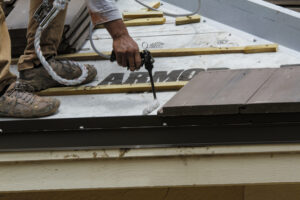If you are looking to install a new roof, you will need to follow a few simple steps. The first step is to determine the condition of your existing roof. Next, you will want to make sure you have all of the necessary materials before starting. This includes starter shingles, sheathing, underlayment, and drip edge. Click Here to learn more.
Starter shingles are an important part of any roof installation. They serve as a barrier between the field shingles and the seams, which prevents leaks. These shingles are also an essential part of wind resistance. In high wind zones, they prevent uplifts from strong winds.
Starter shingles are made from fiberglass-reinforced asphalt shingles. They are usually rectangular and are topped off with natural roofing granules. The tar strip on the bottom of the shingle is also important since it serves to help keep the edge of the roof down.
Starter shingles are typically a bundle of 18, which yields 118.1 linear feet of coverage. This is enough to cover about half an acre of the roof. If you’re installing a new roof, it’s a good idea to measure the area before you buy.
The best starter shingles have at least two-and-a-half inches of headlap. The self-sealing strip that’s installed on the bottom of the shingle is a good sign, as it will stop blowoffs.
As a rule of thumb, it’s a good idea to install the starter shingles on the outermost roof edge. This will allow the shingles to be nailed down evenly across them.
The proper placement of the shingles is a critical factor in ensuring your roof will perform well in all aspects, from rain to wind. It’s a good idea to use the corresponding nails for every course and to place the nails at least 1 1/2 to 3 inches from the edge of the shingle.
There are a few other things to remember. You should also ensure that your foundation is solid. Installing a shingle without a base is a surefire way to cause damage, which can cost as much as $300.
It’s important to choose the right underlayment for your roof installation. Choosing the wrong material can cause problems and result in a lower-quality job. In addition, it may void your warranty.
There are two main types of underlayment available for roofing projects. These include felt paper and synthetic underlayment. Both provide protection from wind and moisture, but each has its own advantages.
Felt underlayment is made of plant fibers soaked in bitumen. It’s lightweight and provides superior tear resistance. While it’s more affordable than other roofing materials, felt isn’t always the best choice for your project.
Synthetic underlayment is a newer option that offers benefits like durability and wrinkle-free performance. They are a good alternative to the felt paper underlayment, but they are a bit more expensive.
Rubberized asphalt underlayment is another option. Unlike felt, rubberized underlayment is waterproof. This means it’s ideal for areas where you don’t want to leak. But it’s also very heavy. You’ll need to lay out the material and use a ladder to install it.
Whether you’re installing a metal or shingle roof, you’ll need underlayment. Underlayment is designed to protect against water and wind, and it acts as a barrier between your roofing materials and the inside of your home. Roofing underlayment comes in rolls or in smaller pieces. Depending on the size of your project, it’s recommended you purchase a roll that covers about one hundred square feet.
Generally, it’s best to install synthetic underlayment on a flat roof deck. However, depending on the type of underlayment you buy, it can be installed on sloped roofs as well. If you’re not sure which product to buy, ask your contractor or a manufacturer for a recommendation.
When it comes to installing a drip edge on your roof, it is best to rely on a professional. Doing it yourself can lead to mistakes that will cost you money in the long run. In addition, improper installation can cause damage to your home’s framing.
Installing a drip edge is a good way to reduce the risk of damage to your home. This piece of metal redirects water away from your home’s fascia, shingles, and other vulnerable areas. It is also a nice decorative addition.
To install a drip edge on your roof, remove any existing shingles from the roof’s edge. Then, loosen the lower run of the roof so you can access the tools and materials you need.